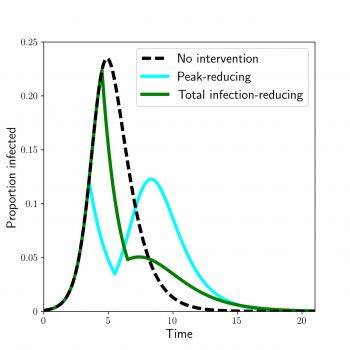
Mathematical modelling of intervention timings by Prof Istvan Kiss and colleagues
As COVID-19 spreads across the UK and around the world, many people are asking when is the right moment for governments to make major interventions to slow the spread of the outbreak.
Professor Istvan Kiss is a Professor of Applied Mathematics at the University of Sussex and is an expert in modelling how diseases spread. He, together with Dr Joel C Miller (La Trobe University, Australia) and Francesco Di Lauro, a research student from Sussex, have published a new paper which looks at the question: if a government has a one-shot major intervention to make, when should it make it?
The paper starts with the assumption that governments can make a major intervention – such as a closing public transport networks, businesses or even an Italian-style lockdown – only once and for a limited duration. That's because people are known to fatigue from such measures so the key question is: at what moment are these major interventions most impactful? If an intervention definitely cannot be sustained for an extended period of time, then the paper finds that it is best if it is 'held in reserve' until there is a smaller number of people who are still susceptible to infection. After a certain point "herd immunity" develops across a community, which reduces the rate of infection.
School closures could be considered either a long or short term measure, where short term means a couple of weeks and longer term means several months. That's a decision for policy makers.
The paper found that if a government's aim is to minimise the total number of people infected, then the major intervention should be brought in just before the peak, so that there is no rebound once the intervention has stopped. The paper also found that if the aim is to reduce the height of the peak (the number of people infected at the outbreak's most intense moment) then the intervention should be started earlier. This results in two lower peaks, as people return to their normal behavioural patterns when the intervention has been stopped – or when they have grown tired of it - and then the infection begins to spread again. In this second scenario, more people will be infected overall but the impact on the health service is spread out in time.
Professor Istvan Kiss from the School of Mathematical and Physical Sciences at the University of Sussex, says:
"Our analysis shows that a one-shot intervention is more effective if it is implemented once the number of infections is nearing the peak – although the exact moment that you implement a major one-shot intervention depends on what you're trying to achieve. Governments either choose to intervene later in order to reduce the overall number of people infected, or they opt to intervene slightly sooner. In this second scenario, the outbreak will very likely result in two or double peaks, with potentially more people infected overall but the demands on the health service are more spread out. It's a trade-off. The UK Government seems to be opting for the former – to avoid a rebound.
"Individuals already seem to be opting to practice "social distancing" – such as avoided densely populated events – and for many this is a sensible idea. The effect of such social distancing is that the peak of the epidemic is delayed and may even be reduced. This eases the impact on the health service.
"We're in a different situation than we were in with the H1N1 pandemic in 2009. The fatality rate for COVID-19 is higher and that means that what might have constituted a one-shot drastic intervention for H1N1 might be considered to be more tolerable for a longer period now."
Francesco Di Lauro, a PhD student and doctoral tutor in the School of Mathematical and Physical Sciences at the University of Sussex, said:
"Our models address the biggest question facing the world right now: what should governments be doing in response to the COVID-19 pandemic? If governments want to make a drastic intervention, they probably only have one chance. This is the most critical public heath decision facing governments in a generation – they've got to get it right.
"The question of school closures has been much debated and the answer depends on whether governments consider them to be a short or a long term measure, relative to the length of time it takes to recover from the virus, which is around two weeks. If policy makers consider school closures as a short term measure then it makes sense to wait until we're closer to the peak. If they consider it a long term measure - lasting several months - that that process should start now.
"As a PhD student it's been absolutely fascinating to work on this important paper – we've been working around the clock on the analysis. We plan to publish more soon, and we're reviewing our results as we watch the evolving situation and the emerging data."
Dr Joel C. Miller, a Senior Lecture at the Department of Mathematics and Statistics at La Trobe University in Bundoora, Australia, said:
"In the face of the current pandemic, it is important for governments to be aggressive in their interventions and act quickly. However, some interventions simply cannot be sustained for a long period. These interventions have little overall impact if they are applied too early, but if they are timed right, they can have a significant impact on the course of the epidemic."






